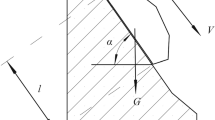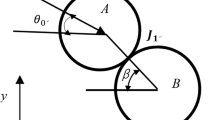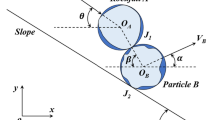Abstract
Rockfall is a frequent engineering disaster confronted in the capital construction engineering. The key for preventing rock fall is the evaluation of the rockfall trajectory. After extensive analysis, an innovative calculation method of rockfall trajectory, called segmented cycling algorithm, has been proposed in the paper. According to the contact relationship between the rolling stones and the slope surface, the movement divided into three sections which include the bouncing phase, the rolling (sliding) phase and collision phase, the formulae to calculate the velocity of different phases of motion are proposed respectively by segmented cycling algorithm. A similar model, based on a rock slope in Chongqing–Wanzhou highway, is established to verify the capability and validity of the presented algorithm. Compared with existing algorithm, the new algorithm is simple and clear, easy to use and so on. The algorithm meets the law of the movement of rockfall and can be used to forecast the kinetic feature of rockfall. It is also used as the basis for rockfall disaster prevention.




Similar content being viewed by others
References
Chau KT, Wong RHC, Wu JJ (2002) Coefficient of restitution and rotational motions of rockfall impacts. Int J Rock Mech Min Sci 39(1):69–77
Hu H (1989) Collapses and rockfalls. China Railway Publishing House, Beijing
Huang R, Liu W (2008) Study on the movement characteristics of rolling rock blocks on platform. Adv Earth Sci 23(5):517–523
Jiang J, Yokino K, Yamagami T (2008) Identification of DEM parameters for rockfall simulation analysis. Chin J Rock Mech Eng 27(12):2418–2430
Lina Z, Keping Z, Feng G et al (2008) Motion characteristics and control of rockfall of open-pit slope. J Catastrophol 23(3):76–79
Liu Z (2000) Geological hazard investigation guide. China Geological Publishing House, Beijing
Lu Q, Sun H, Zhai S et al (2003) Evaluation models of rockfall trajectory. J Nat Disasters 12(2):79–84
Shen J, He S-m, Wu Y (2008) Present research status and development trend of rockfall hazards. J Catastrophol 23(4):122–126
Stevens WD (1998) Rocfall: a tool for probabilistic analysis, design of remedial measures and prediction of rockfalls. University of Toronto
Tang H, Yi P (2003) Research on dangerous rock movement route. J Chongqing Archit Univ 25(1):17–23
Ya N, Wang L, Zhao Q et al (1996) Simulation study of rockfall kinematics. J Geol Hazards Environ Preserv 7(2):25–32
Yang Z, Zhang L, Shang Y (2002) Two engineering geomechanics subjects to be worth paying close attention. J Eng Geol 10(1):10–14
Zhang L, Yang Z, Xu B (2004) Rockfalls and rockfall hazards. J Eng Geol 12(3):225–231
Zhu B (2010) Study on rockfalls’ motion characteristic on rock slope and disaster protection. M.S. thesis, Chongqing University
Author information
Authors and Affiliations
Corresponding author
Rights and permissions
About this article
Cite this article
Irfan, M., Chen, Y. Segmented Loop Algorithm of Theoretical Calculation of Trajectory of Rockfall. Geotech Geol Eng 35, 377–384 (2017). https://doi.org/10.1007/s10706-016-0113-8
Received:
Accepted:
Published:
Issue Date:
DOI: https://doi.org/10.1007/s10706-016-0113-8




